Beach volleyball is a game of skill and finesse. The game of the pros and the weekend warriors’ game are as different as Michael Phelps’ butterfly and a doggie paddle. They’re both “swimming,” but that’s where the comparison ends. The same goes for many other skills in beach volleyball, including serving the ball. An underhand lollipop serve right to your lap and a topspin stinger from AVP champion April Ross down your line are apples and oranges.
But this is why our sport is so beautiful – anyone can play, and there’s no end to learning or improvement- even for the pros. Repetition, film, visualization, and instruction build on each other, creating a foundation at first, and eventually, when you’re Phil Dalhausser status, a skyscraper of brilliance.
So we have decided to dissect each skill over a series of articles, with the disclaimer that I can only scrape the surface & you need some one-on-one tutorials to dive deeper. Every skill involves countless elements, from varying opinions to preference to athletic ability (no matter how hard I try, I cannot serve like Jeremy Casebeer, I have come to terms with that). As every match and every point begins with serving the volleyball, we’ll start there too!
There are essentially four different service techniques: I’ll break down all four, giving the generally accepted guidelines for each as a right-handed athlete.
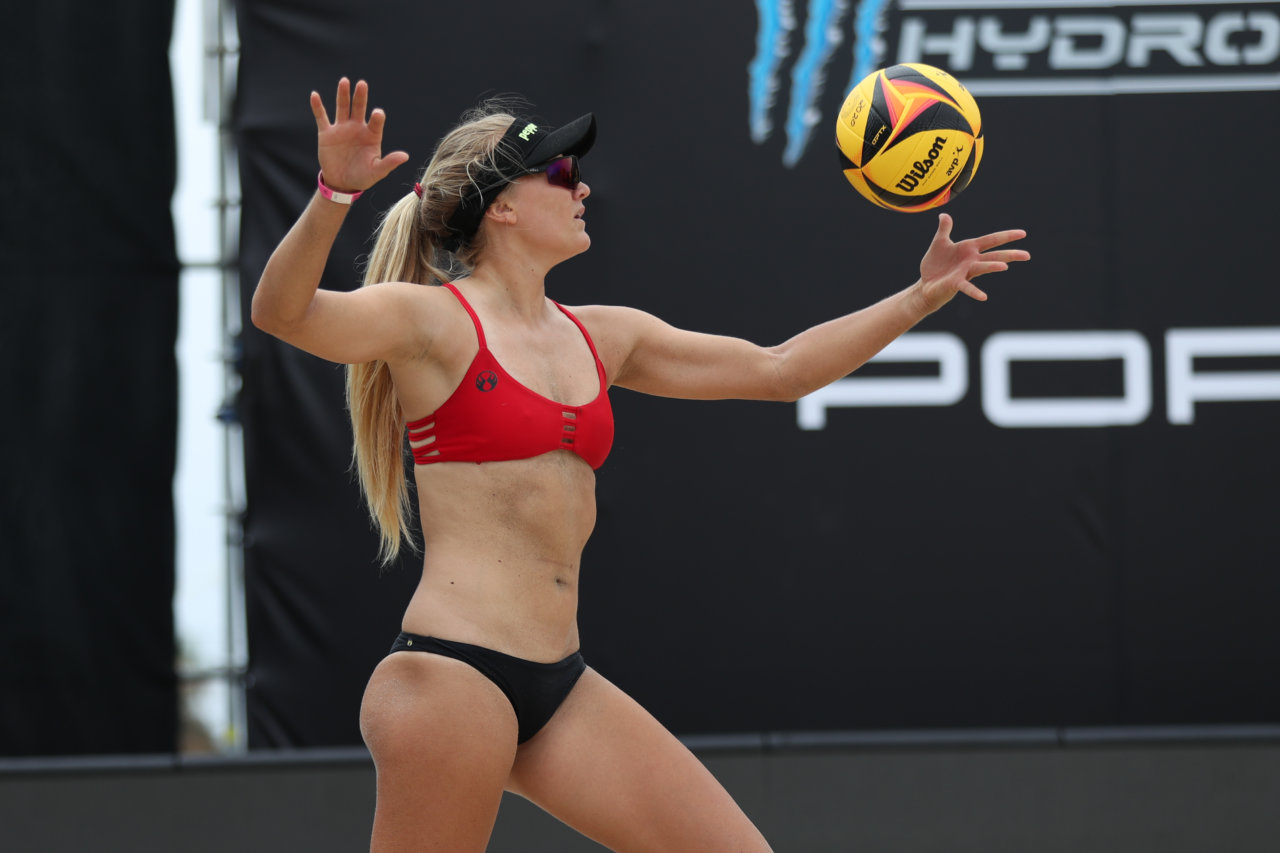
What is a ‘Standing Float Serve?’
This is the most basic option and the one I prefer because apparently I’m basic. It’s a simple serve that can potentially yield rewarding results. A standing float goes like this:
- Hold the ball straight in front of you with your left arm. Stagger your feet vertically with your left foot forward. Your right arm is up in the air, ready to attack the serve.
- With your left hand, throw the ball over your right shoulder.
- Take a step with your left foot as your right hand attacks the ball at your highest contact point with a flat hand on the backside of the ball.
The flat hand is crucial when serving the ball; it’s why this modus operandi is called a float serve. If you avoid putting any spin on the Wilson Optx, that little yellow and orange demon will dance all over the court as it crosses from your side to theirs. A good float is an unpredictable and quick death given it’s float and drop effect.
The ball may “bottom out,” meaning it’s at one height and suddenly drops. As a passer, this is a surefire way of looking like you’ve never played volleyball before. The ball could either inexplicably drop a foot in front of your platform, or you confidently call it out of bounds right as it drops well inside the end line. A float also “dances” in the wind. Without spin, the ball is at the mercy of even the lightest of breezes.
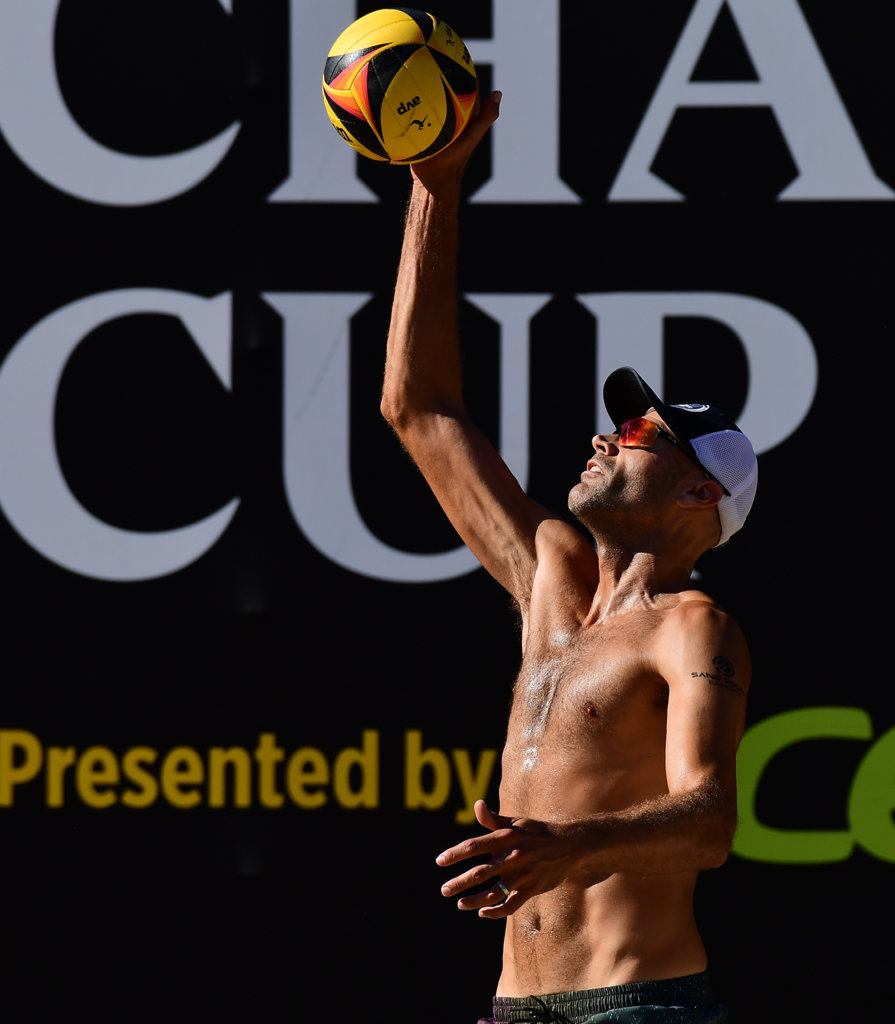
What is a ‘Standing Topspin Serve?’
This is the least-seen serve on the AVP Pro Tour for a simple reason (explanation to come). But first – the technique:
- Begin much the same as a standing float, unless you decide to serve with the same hand that you toss with. This is rare for a standing topspin but isn’t unheard of.
- Toss the ball over your right shoulder.
- Contact the ball at your highest point, starting low on the backside of the ball and rotating your hand up the back of the ball as you hit it. Think of putting a spin on a free throw (cookie jar for all of you former little leaguers).
I relate the two because that’s exactly what a spin serve is meant to do regardless of standing or jumping – spin the ball. It’s best used when the wind is blowing in your, and your opponent’s, face. For whatever reason that physics dictates (I’m not going to even try), a topspin volleyball serve in the wind will eventually drop like a rock. The reason a standing topspin is rarely used is it’s, more often than not, too easy of a serve. If the passer can track the ball coming across the net and get underneath the ball with a solid platform, a spin serve is straightforward to pass. A float serve like mentioned earlier, may rudely spray off your arms; a topspin volleyball serve honors a flat platform and often results in a perfect pass. The only time I’d personally ever use a standing topspin is in a straight, heavy wind to try to get the ball to drop quickly. And the reason I would stay standing instead of a jump topspin (see next section) is so my opponent wouldn’t know I’m switching from a float serve to a topspin serve until after I contact the ball. But when it comes to topspin, most players prefer…
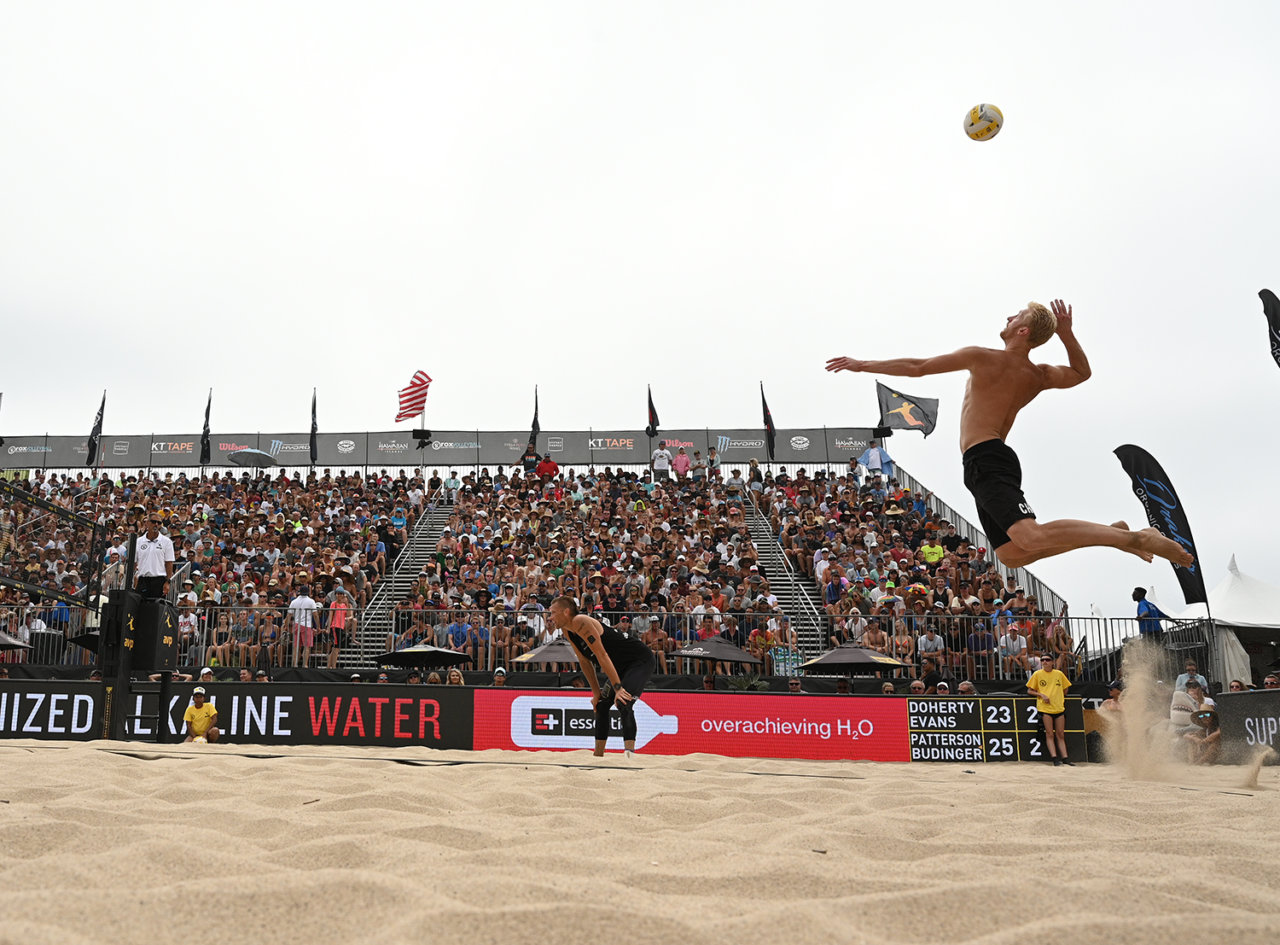
The ‘Jump Topspin Serve’ (also commonly referred to as just jump serve)
This is the volleyball serve that is the classic point-scoring ACE. The one that photographs beautifully. The one that you think you’re capable of doing until you attempt it and realize it’s insanely challenging and physically exhausting. I mean, look at that form – that’s literally the AVP logo. Let’s break down the technique of the famous volleyball jump serve:
- Hold the ball straight in front of you with your right hand (in a jump topspin, almost everyone throws with the same hand they serve). Your feet are staggered with your right foot forward. Your left arm is down, ready to swing on your jump.
- Toss the ball high and with spin, 3-5 feet in front of your right arm. The toss is arguably the most crucial part of a successful jump serve.
- As your right hand falls from the toss, it joins your left in a scooping motion behind you as you take a big left step.
- Then step right-left quickly, creating a platform of the sand and balancing your jump.
- Jump. Hopefully, you’ve gauged the toss right because there’s no going back. Beach volleyball does not allow redos on the serve.
- Contact the ball at your highest point, starting low on the backside of the ball and rotating your hand up as you hit, the same as a standing topspin serve.
A well-executed jump serve is as powerful and hard to pass as an attack at the net. Geena Urango can paint your line in less than a second from her contact on the endline to the ball dropping on your side of the net. Tri Bourne loves rocketing one down the middle, confusing his opponents on whose ball it is. April Ross has won Best Server in the world and on the AVP like a million times with her jump serve (research amnesty). Jeremy Casebeer has won matches from the service line more than once, and Jake Gibb credits Casebeer’s AVP Seattle Open title to his jump serve that Taylor Crabb and he could NOT figure out. Part of the reason the jump serve in volleyball is so successful is because it allows more power for the server (which leads to less time the ball is in the air for the opponent to track and pass) and you are hitting the volleyball at a higher point than the standing spin serve (which creates different angles in the trajectory of the ball and harder for your opponent).
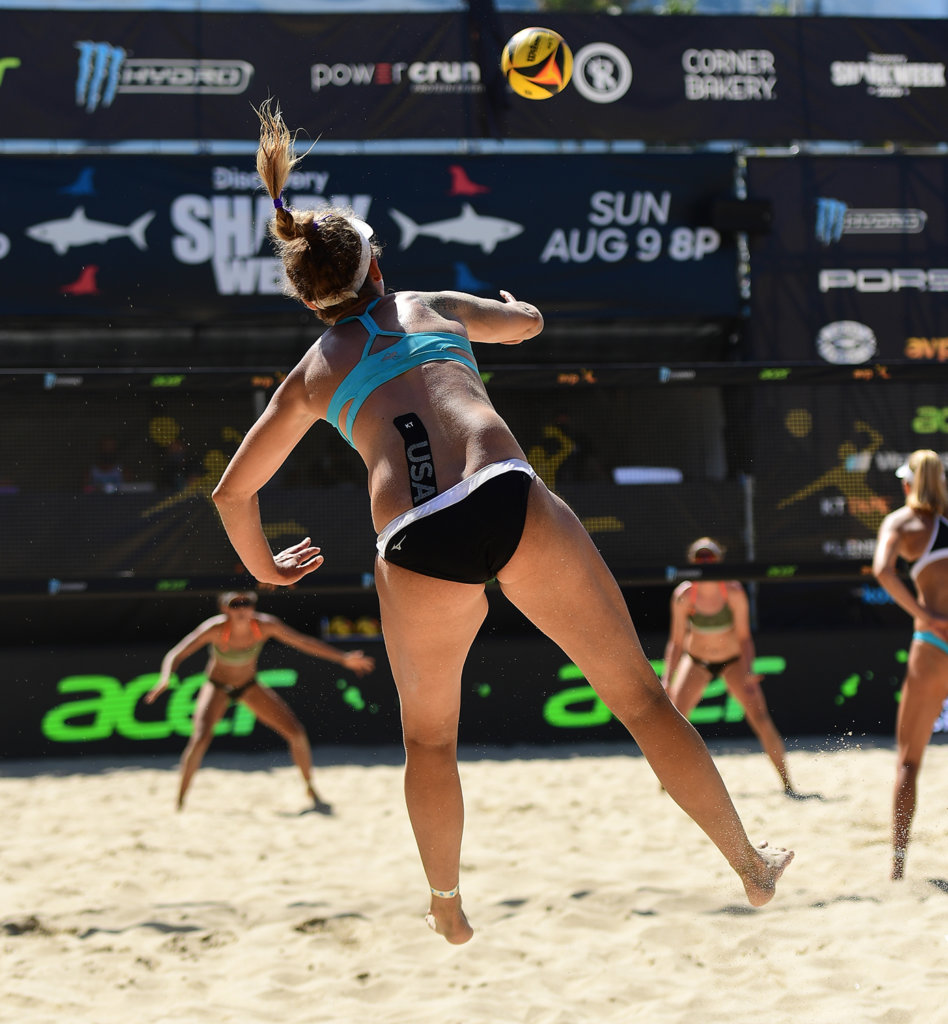
But a jump serve is the most physical option, taking a lot out of the athlete. A blocker who jump serves & runs up to the net each play is a beast (even though some do so because their momentum makes it easier to run to the net after service). You’ll notice some athletes after a long day of three-set matches switch to a standing float serve to conserve their energy. Jump serves are also the hardest to master and the hardest to control as a server. The fact that the athletes with the most aces also often have the most misses is no coincidence. High risk, high reward.
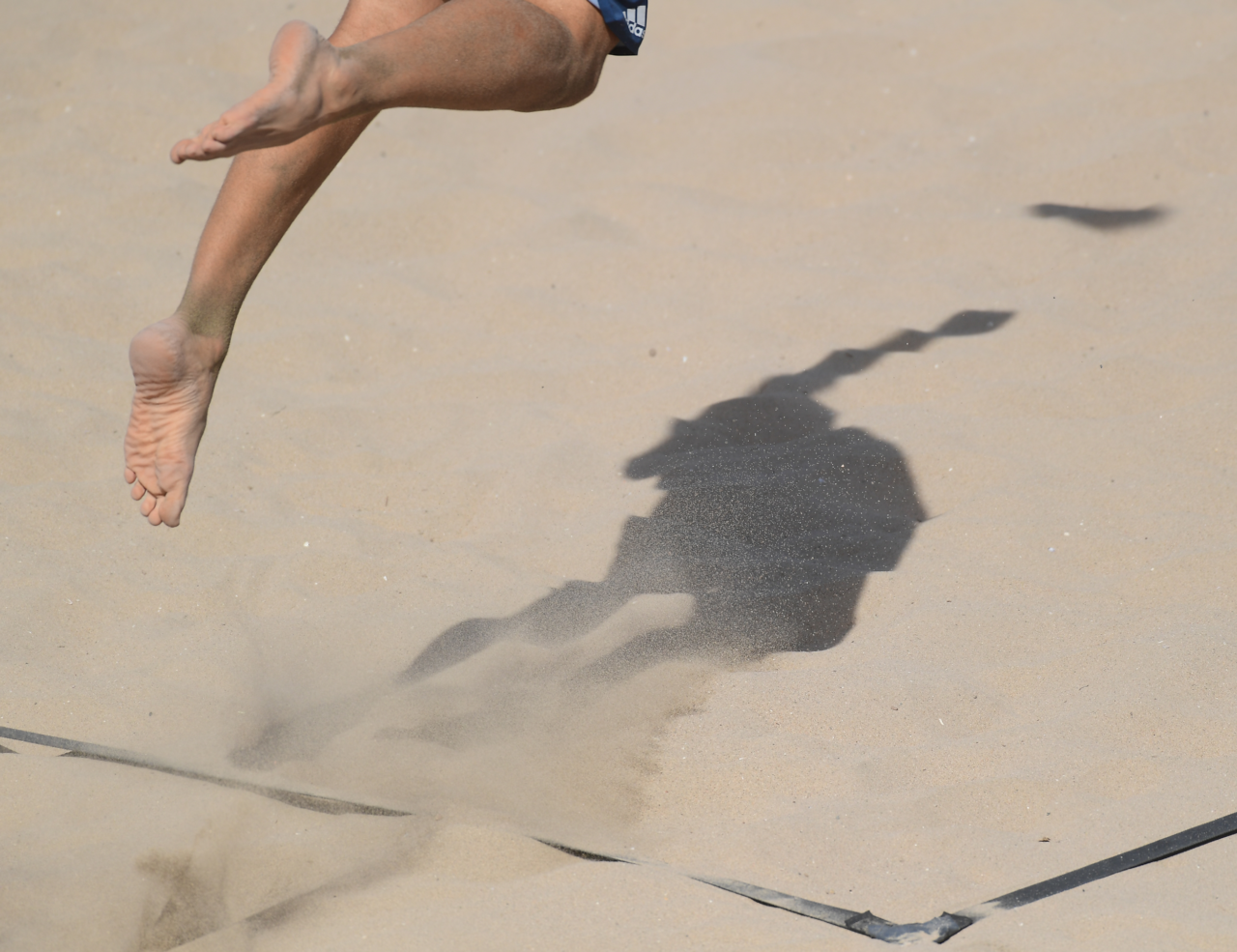
What is the ‘Jump Float Serve?’
By now, you’re a service wizard and can probably ascertain what this serve is. But for continuity’s sake & sticking to the skill’s technique:
- Hold the ball straight in front of you with your left arm. Your feet are staggered with your right foot forward. Your right arm is up in the air, ready to attack the serve.
- Throw the ball in the air with your left hand over your right shoulder.
- Step with your left foot (the length depends on preference, I prefer a small almost skip step).
- Then step right-left quickly, creating a platform of the sand and balancing your jump.
- Jump.
- Attack the ball at your highest contact point with a flat hand on the backside of the ball, trying not to spin the Wilson Optx at all.
A jump float provides more power than a standing float serve and packs a powerful punch. Betsi Flint can leave a Wilson tattoo on your throat with her serve. These types of serves also give a server that physical momentum that gets them onto the court faster, so he/she is ready for defense. This is especially important if you’re serving well, as the other team may overpass it, and you have to be ready quicker. The worst is when you serve an awesome ball just for it to drop on your side because you were admiring your serve and didn’t get back on defense in time. Not that that’s ever happened to me or anything…
Which serve in volleyball should I use?
Each serve has its pros and cons. Standing float conserves energy but isn’t as powerful. The jump topspin serve can be gnarly but also impossibly unforgiving in the error department. Routine helps a lot of athletes cut down their errors. We all have a routine, whether it’s a spin, a breath, an extra look – each player has some series of movements, centering, or breathing that puts them into the right state to serve. Ignore routine at your peril – almost every time I serve in haste, I error.
Another factor is location. Aiming for someone’s line is a higher risk than going for the middle of the court. Sometimes you target one player. Sometimes you just go for the ace. Sometimes you’re going for the seam between two players to muddle their communication. When serving one player, there’s also the added factor of where you’re placing the ball. If you serve someone to their line, their only option is to kick outside the court after they pass and attack from there. If you serve them more towards the middle, they’re already positioned in the middle and will likely take their set there. This is why it’s essential to know tendencies. If your opponent favors hitting from the middle or outside the court (or is particularly bad at one of those), you want to put them in an unfavorable location so they’re not hitting their forte.
Some athletes prefer to pass on one side of their body, too, so you want to serve them on their other side to make them uncomfortable. The short/deep serving method is often used on blockers to tire them out and keep them guessing (blockers like me; I hate short/deep serving routines). This is when you serve really short and then the next serve is a deep serve, alternating between the two so your opponent can’t find a rhythm. Short serves are tough for a tall blocker to get underneath it and get a good pass. Deep serves are great for opponents who don’t want to move too much or struggle to open up their shoulders to take a deep pass.
There are obviously a lot of nuances to serving style and location, too many to outline. And each coach and player are different; everyone has their own take on best practice. But we all agree, scouting is an essential part of the service game. If you know your opponent, you can serve where they are weakest and put yourself in a better position to score a point.
I mentioned wind before, but it can be everything in regards to strategy if it’s strong. The wind may be swirly on Stadium Court – the breeze coming through the various openings into the court, mixing directions and speeds to spiral into a mini vortex. This makes for an unpredictable wind and can be really fun. On Southern California beaches, we often have a diagonal wind from the southwest off the ocean. This makes the ocean side of the court the “bad side,” meaning the wind is pushing the ball back into bounds, and the server can put more power onto their serve without it flying out of bounds.
Last note (for now) – difference in the make of the volleyball. I’d go into this, but there isn’t a strong consensus among athletes on which ball is the “better ball.” The FIVB Molten volleyball is slippery and small, making it harder to pass and, therefore, easier to ace. But the Optx Wilson spins so nicely, giving the jump spinners an extra umph. There’s also the old yellow & white Wilson, the Norceca red & white & blue Molten, and the black & white Spalding favored on the East Coast. Each ball offers something different, something undefinable and unique to the athlete.
I encourage you to try all the serves with each ball (except the Norceca ball… sorry guys, not a fan) and find your cup of tea. And as always, stay tuned for more from me. Reach out @kimesmith21 on Instagram to let me know any of your serving tips and what skill you’d like to see next!